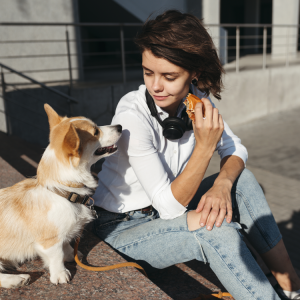Dogs Really Do Understand Speech Buttons, New Study Finds
Those viral Tiktok videos may not be all smoke and mirrors.

Share Article
If you scroll long enough on Tiktok (and who hasn’t?), you’ll inevitably stumble across a video of something humanity once only dreamed of: a talking dog. It’s not science fiction. For the past few years, pet parents have been teaching their dogs (and cats!opens in new tab) how to use speech buttons to receive cues and communicate their desires. Some, like an iconic Sheepadoodle named Bunny, have gathered millions of devoted followers.opens in new tab
But, welcome to the internet: There are a whole lot of naysayers. In the comments, many people question how well the speech buttons really work, and whether or not pets are really understanding language when they communicate with them. In a new studyopens in new tab published in PLOS One, researchers looked for answers — and they found that dogs do in fact understand words spoken by speech buttons.
The experiments
Dr. Federico Rossano, a professor at the University of California San Diego, and his colleagues carried out experiments with 59 dogs who had been trained to use speech buttons. The experiments took place in the dogs’ homes.
In the first experiment, a researcher pressed buttons and recorded the dog’s behavior; the researcher was unable to hear what the button said, and the word on the button was covered with tape. The buttons said words related to play, outside, and food: the play words were “play” or “toy,” the outside words were “out” or “outside,” and the food words were “food,” “eat,” “dinner,” or “hungry.”

The researchers wanted to observe if the dogs would “behave in anticipation of the actions or events indicated by these words,' they wrote. Some behaviors they looked out for were picking up a toy after hearing “play” or looking to a food bowl after hearing “food.”
In the second experiment, with a new group of dogs, pet parents themselves either pressed the button or spoke the cue out loud. There were multiple trials, and each dog experienced both a pressed and spoken word.
The results
Researchers found that across experiments, the dogs showed play behaviors seven times more often after hearing a “play” button than they did on average after hearing any of the three buttons. The same was true for outside behaviors. Interestingly, they did not show more food-related behaviors after hearing the food-related cues. The findings were true whether a researcher or pet parent pressed the button or said the word aloud.
These results indicate that dogs are likely truly listening to speech buttons — and not just reacting to their pet parents’ body language. “Here we show that actually [dogs] do pay attention to the [soundboard] words and they produce appropriate behaviors independently of environmental cues and who produces the word,” Dr. Rossano toldopens in new tab The Guardian.
Granted, these results aren’t jaw-dropping. It’s pretty well established that dogs can understand many wordsopens in new tab — Rossano admits this himself. “While this study is most certainly not mind-blowing, it is a necessary first step,” he told The Guardian. The researchers hope to aim future studies on how many (and what kind of) words dogs can understand using buttons, as well as whether or not dogs can use buttons themselves to produce appropriate responses.

Sio Hornbuckle
Sio Hornbuckle is the Assistant Editor at Kinship, where they frequently write for the site. As a writer, they specialize in pet news, animal science, and pop culture. They live in New York City with their cat, Toni Collette.
Related articles
![Brown, half breed dog sitting on a chair next to his owner, a blonde stylish woman wearing a brown smart suit.]()
Your Dog Can Read Your Mind, Kind Of
Researchers say dogs actually have a pretty good sense of what we’re thinking.
![corgi giving woman puppy dog eyes begging for food]()
A New Study Debunks the Theory That “Puppy Dog Eyes” Are for Humans’ Benefit
Apparently wild dogs can be pretty cute, too.
![Illustration of a woman hugging a dog]()
Your Dog Can Smell When You’re Stressed, New Study Says
Research finds that your pup can smell when you’ve been doom-scrolling, and they get bummed out.
![Couple hugs their merle Boxer]()
How to Improve Your Relationship with Your Dog
Animal behaviorist Dr. Karen B. London on how to strengthen your pet-parent bond.
![]()
To Cry Is Human—and Apparently Canine
Time to whip out The Notebook for a little doggie movie night.
![Jack Russell puppy grunting while laying on blanket and crying out]()
Listen Up! Your Puppy Is Trying to Talk to You
How to make sense of all those grunts and whines.







